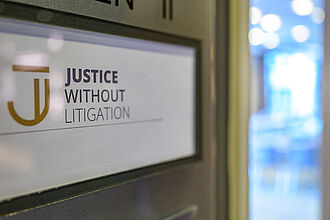The notarial practice is undergoing an extensive modernisation. There are two draft proposals which are setting the course for a further digitisation of the notarial practice: The introduction of an electronic in-person authentication will make it possible to create original electronic authentic instruments in the traditional face-to-face procedure at the notary's office. The project “eNoVA” (Electronic Notary Administration Exchange) will comprehensively digitise the execution of notarial legal transactions, especially real estate transactions.
Both legislative projects aim to speed up processes, preserve resources, and make the work of all parties involved noticeably easier without compromising legal certainty. This will not only make the notarial profession more modern and efficient, but also significantly contribute to the digital transformation of the judiciary and administrative agencies.
Electronic in-person authentication
On July 16, 2025, the government published its draft bill introducing electronic in-person authentications. It provides the legal basis to create notarial authentic instruments electronically in the notarial office, for example by using a signature pad. This helps to avoid disruption between media, saves resources in notarial offices, courts, and other public entities issuing authentic instruments while taking sustainability into account.
The advantages of original electronic authentic instruments
Original electronic authentic instruments are essential to avoid double disruption between media that have been necessary since the introduction of the electronic archive of authentic instruments in 2022: Currently, the notarial authentic instrument is being prepared in a word program and printed afterwards. As there are often changes to the text in the course of the authentication process, a new printout is necessary. After concluding the authentication, the authentic instrument is scanned for storage in the electronic archive of authentic instruments and for use in electronic legal transactions. Occasionally, a second scan with a smaller file size is created for the electronic ancillary file. These multiple changes will be avoided in the future. In addition, original electronic authentic instruments have a better image quality with a smaller file size than scans and are machine-readable and searchable.
Practical implementation
The process of authentication, and in particular the signing process by the parties involved and the notary, will change with the implementation of the electronic in-person authentication. In the future, the parties involved will be able to sign by hand on a hardware device suitable for capturing signatures electronically, such as a signature pad. Subsequently, the notary will add his qualified electronic signature. This easy while secure procedure is a welcome development. It transfers the proven act of signing by hand as an expression of approval to the digital sphere in a functionally equivalent manner. Furthermore, a visual reproduction of the parties' handwritten signatures increases the acceptance of electronic documents in legal transactions.
The notary's qualified electronic signature protects the authenticity and integrity of the authentic instrument. The signature certificate, which complies with the standards of the eIDAS Regulation, allows to verify the notary at any time. In addition, any subsequent changes to the electronic authentic instrument can be traced. The German Federal Chamber of Notaries has developed an application that will be provided to its notaries at no additional cost.
Scope of application
In contrast to notarial online procedures, the possibility of an original in-person electronic authentication extends to all subject matters of authentic instruments with the exception of testamentary dispositions. In addition, electronic signatures executed before a notary can be certified by the latter.
The decision as to whether a document should be drawn up in electronic or in paper form is at the discretion of the notary. In addition to notaries, other officials (probate courts, youth welfare offices, guardianship authorities, consulates) will be able to draw up documents in electronic in-person form in the future.
Electronic Notary Administration Exchange (eNoVA)
The “eNoVA” project aims at a comprehensive digitisation of the execution of notarial legal transactions, in particular real estate transactions. On July 9, 2025, the ministry published a corresponding draft bill according to which numerous notifications, applications, and approvals will be transmitted digitally and in a structured form between notarial offices, courts, and authorities.
Digital instead of postal processes
Until now, communication between notaries, courts, and authorities still often take place via postal exchanges, leading to disruption between media and requiring repeated data collections. With eNoVA, communication exchanges will shift to secure digital channels – faster and more efficient, while at the same time ensuring legal security. This will eliminate millions of pieces of postal mail as well as redundant data entry and scanning.
The electronic communication with courts and administrative authorities will take place via the so-called “EGVP infrastructure” (the electronic court and administration mailbox) in the future. The established electronic communications with commercial registers and land registries serve as a model. For years, notaries have been communicating electronically with courts in these areas in a structured form via the EGVP infrastructure. Documents can be sent in seconds with end-to-end encryption. The use of structured data sets enables efficient further processing. In order to enable secure, digital, and structured communication with tax authorities that do not use the EGVP infrastructure but instead rely on the ELSTER system (tax authority communication system), the German Federal Chamber of Notaries has integrated this into the notarial application as well.
Practical implementation
The draft bill provides for a gradual digitisation. The German Federal Chamber of notaries will provide notarial offices with the module “eNoVA” to allow for the practical implementation of digital executions. Since March 2024, notaries have already been able to use this module to transmit digital messages to public property valuation committees to collect information on real estate prices. On the same basis, further steps to execute the authentic instrument (in particular tax notification obligations, pre-emptive right inquiries, and court or authority approvals) will also be comprehensively digitised. eNoVA enables formal and legally compliant digital exchanges between notaries and government agencies in both directions. An example is the issuing of judicial authorisations (family court, probate court, guardianship court, agricultural tribunal) and, prospectively, the electronic return of the so-called clearance certificate, which provides proof of payment of the real estate transfer tax.
Looking ahead: end-to-end digitisation
The projects “Electronic In-Person Authentication” and the “Electronic Notary Administration Exchange” are laying the foundation for a fully digitised notarial office. The consistent electronic creation and processing of notarial authentic instruments and legal transactions avoids disruption between media, increases efficiency, and saves resources. This will create a modern notarial office that not only seizes the opportunities offered by digitisation, but also plays a pioneering role in the digital transformation of the judiciary and administration.



![[Translate to Englisch:] [Translate to Englisch:]](/fileadmin/_processed_/d/0/csm_GettyImages-2217360625_1200x800_728e2ae63c.jpg)
![[Translate to Englisch:] [Translate to Englisch:]](/fileadmin/_processed_/4/3/csm_GettyImages-504651480_1200x800_0eba877782.jpg)
